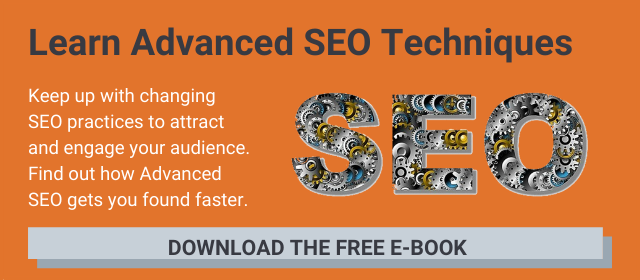SHARE
Want to Master SEO? A Guide to Search Engine Optimization
.png)
Search engine optimization, or SEO, is central to a good inbound marketing strategy. It helps your website get found faster by search engines, boosts your search ranking, and turns your content into a user-friendly sales tool. Check out this comprehensive guide to SEO — from "what is SEO?" to advanced techniques and the latest trends.
Table of Contents
1. SEO Basics
2. Keywords, Keywords, Keywords!
- Identifying Powerful SEO Keywords
- Choosing the Right Keywords for Your Business
- Using Long-tail Keywords
5. Advanced SEO Implementation
- Use Advanced SEO Techniques to Get High-Quality Leads
- Attracting the Right Buyers With SEO
- SEO Trends and Techniques to Try
Learning the Basics of SEO
SEO is a vast and ever-expanding aspect of inbound marketing. When you're trying to get started, it can feel overwhelming. But fear not — despite the rapidly evolving algorithms and trends, there are still lots of SEO basics that remain pretty consistent.
What is SEO
SEO, or search engine optimization, is an inbound marketing technique that involves optimizing your marketing content based on what people are actually searching for, and creating quality content that answers your potential customer's questions. Learn more about how to attract your ideal customer with SEO.
How to Use SEO
The key to SEO is using it efficiently, and not getting overwhelmed by the near-endless possibilities for content and applications. Stick to what you know, and create quality content. Here are 4 tips on how to use seo to increase website traffic.
How to Choose an SEO-Friendly URL For Your Business
If you're researching SEO and you haven't created your website yet, choosing an SEO-friendly URL is a great place to start.
All About SEO Keywords
Keywords are foundation of a good SEO strategy. Using platforms like HubSpot, SEMRush or Ahrefs, you can identify keywords and keyword phrases that customers are actually using to look for products and services like yours.
5 Simple Secrets to Identifying Powerful SEO Keywords
Keyword research is a detailed process, but it doesn't have to be tedious. With a comprehensive understanding of your customer personas and their needs, as well as a clear and simple organizational system for your selected keywords, you'll be away to the races. Check out 5 simple secrets to identifying powerful seo keywords.
Choosing the Right Keywords for Your Business
There are millions of keywords that attract hundreds of thousands of searchers. But how do you pick keywords that reflect your business, get your content seen, and bring in the ideal customers? You need to know your business, and your customers, back to front.
Here are a few questions to consider:
- What unique services or products do you offer?
- What would potential clients need to search to find you and your services?
- What makes you different from your competition?
Selecting Effective Long-tail Keywords
Long tail keywords, or keywords that have three or more words, are an advanced SEO tool that allows you to answer niche customer questions and solve their problems — maybe even before they knew they had those problems. Here are just a few of the many reasons to use long-tail keywords in your seo strategy:
- higher conversion rates – because the traffic you get is already interested and more likely to make a purchase
- higher search rankings – because more specific long-tail keywords are less competitive
- mitigate risk – because you diversify and don’t depend only on one high stakes keyword
- build authority – by speaking to your area of expertise
Sound intriguing? Follow these 9 steps to select effective long-tail keywords.
SEO and Content Creation
If keywords are the foundation of an seo strategy, content is the house. You need to invite your potential customers in and make them comfortable with high-quality, accessible, engaging content that makes them want to stay for dinner.
Keyword Placement Strategies
Choosing the right keywords is the first step, but placing those keywords effectively in your content is just as important. To get picked up by Google's algorithm, you need to make sure that your keywords are placed in specific spots in your blogs, web pages, and content. For example, keywords need to be in your heading 1, your heading 2s as much as possible, and in the metadescriptions of your photos. Check out this blog post for more details about placing your keywords.
Creating Quality Content For Effective SEO
Good keywords can get your leads in the door, but quality content will actually help convert leads into happy customers. Good content writing is not stuffing as many keywords in as you can, but rather, creating engaging, relevant and timely content that answers questions and meets the needs of your leads and customers.
Managing Duplicate Content For Better SEO Results
Duplicate Content is an SEO term that refers to similar or identical content appearing in more than one place (URL) on the internet. You might plan to duplicate content by using the same quotes or text on multiple pages, or on a referring blog. However, duplicate content can be flagged as spam by referring search engines, bringing down your content's ranking and your site's authority. Check out these tips on managing duplicate content to ensure you maintain your SERP rankings and authority.
Google Tools & SEO
Google has many different tools that help you implement, manage and monitor your inbound marketing efforts.
Using Topic Clusters in SEO
Topic Clusters, while not exactly a tangible tool offered by Google, are an excellent strategy that can help you work with the Google algorithm for increased traffic and engagement on your website. By properly categorizing and linking your content and keywords, you can signal to Google that you are the expert on a given topic — and that your content should rank highly on the search engine results page. Check out tips for using topic clusters here.
Use Google Tools to Improve Your SEO
Advanced SEO Implementation
Strategic keywords and high-quality content are the basics of your SEO strategy. Check out these resources to take your SEO game to expert level.
Use Advanced SEO Techniques to Get High-Quality Leads
Try some of these tactics to target user intent and get more leads onto your site:
- off-page SEO
- technical SEO
- website updates
Attracting the Right Buyers With SEO
Unfortunately, SEO is not a simple or fixed strategy. If you've set up your website and written some strong content using keyword optimization, you're off to a great start, but the work isn't done. If you want to attract buyers who are actually interested in your brand, you must continue to provide potential leads with helpful, timely content. Here's how.
SEO Trends and Techniques to Try
Because Google algorithms are always changing and SEO is constantly evolving, it's crucial that inbound marketing teams stay up-to-date on new trends and techniques. Have you tried any of these techniques?
- optimizing your site for mobile access
- making your website voice searchable
- improving load times
- creating roundup posts
- developing pillar articles
Want More SEO Advice? Download the Advanced SEO E-book!
Topics
- Content Creation (297)
- Growth-Driven Design Websites (167)
- Inbound Marketing (144)
- Sales Growth (133)
- Tangible Words (111)
- Search Engine Optimization (85)
- Social Media Marketing (83)
- Blogging for Business (75)
- Hubspot (75)
- Economic Development (64)
- Events & Training (60)
- Company Growth Podcast (49)
- Manufacturing (47)
- Tourism (46)
- Email Marketing (42)
- Case Stories (40)
- Testimonials & Client Feedback (36)
- Education and SaaS (23)
- Google (21)
- Careers (19)
- Inbound Marketing Agency (19)
- Cool Companies (18)
- FAQ (16)
- Alysha Dominico (13)
- Associations (7)
- Food and Beverage (7)
TW Blog Sign-Up
Learn more about how to grow your business and improve your sales team process.







